MOHS Surgery
Named for the late Frederic E. Mohs, MD, who founded the Mohs micrographic surgery technique to remove skin cancers, Mohs surgery is a highly effective surgery that removes skin cancers by excising one layer of tissue at a time. After each layer is removed, it is examined by the Mohs surgeon under a microscope to determine if the tissue is clear of cancer or to precisely map any remaining cancer for excision. This precise microscopic mapping technique enables the surgeon to remove diseased tissue, and spare as much healthy skin as possible.
What Types of Skin Cancer can be Treated by Mohs Surgery?
Basal Cell Carcinoma
Basal cell carcinoma (also known as basal cell cancer) is the most common cancer of the body. While usually slow growing, it destroys skin and other structures as it spreads. Basal cell carcinoma may appear as a small pimple, a shiny bump or a bleeding sore that doesn’t heal.
Squamous Cell Carcinoma
Squamous cell carcinoma (also known as squamous cell cancer), like basal cell carcinoma, can cause extensive destruction of skin and surrounding tissue. However, it can spread to nearby lymph nodes, and occasionally to other parts of the body. Squamous cell carcinoma may appear as a rough, scaly area of skin or a larger growth.
Other Mohs-Appropriate Cancers
Atypical Fibroxanthoma, Sebaceous Carcinoma, and other skin cancers may also be treated with Mohs.
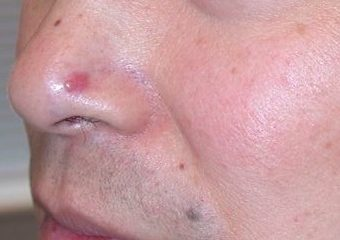
Basal cell carcinoma on the nose
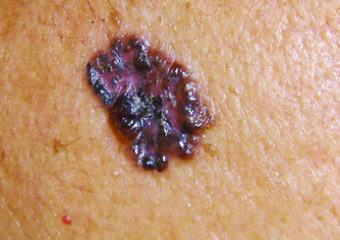
A basal cell carcinoma may be pigmented on skin of color.
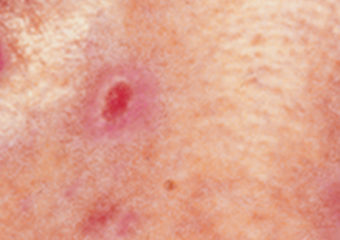
A small pink growth with a slightly raised, rolled edge and a crusted indentation in the center.
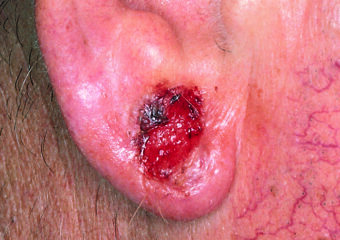
Basal cell carcinoma presenting as an open sore on the ear.
What are the Benefits of Mohs Surgery?
Success rates with Mohs surgery are high for newly diagnosed cancers; up to 99% for basal cell carcinomas and up to 98% for squamous cell carcinomas. Mohs surgery is also highly effective for treating reoccurring skin cancers, even if previous treatments have been unsuccessful.
Because Mohs has both a very high cure rate and conserves healthy tissue, it’s often the treatment of choice for areas such as the face, hands, feet, and shins. The procedure is performed in our office. Typically, the cancer is removed and the wound repaired on the same day without sedation or general anesthesia.
What to expect
BENEFITS
- Removal of the skin cancer(s).
- Treatment of skin cancer(s) with the fewest possible surgical risks.
RISKS
-
Some bleeding, bruising, swelling, redness, scarring and infection may occur during or after any surgery.
-
When an incision is made, there will always be some sort of surgical scar. Our goal is to do the necessary things to keep any scar as inconspicuous as possible.
-
Temporary or permanent loss of or heightened sensation may occur at the surgical site. Some surgical locations such as the temple, mandible, or side of the neck have the risk of nerve injury which could result in weakness or paralysis (loss of function) of the affected muscles.
-
Reactions to anesthetic or other medications may occur.
-
If during surgery, the tumor type or size of the surgical defect becomes too large to be repaired in our office, further surgery or another treatment may be needed.
-
Even if Mohs surgery shows that the above lesion has been completely removed, there is still a risk that the lesion could recur and need further surgery or treatment
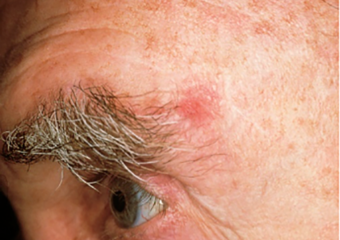
A basal cell carcinoma may be pigmented on skin of color.
Image-Guided SRT Compared to Mohs Surgery
Image-Guided SRT
-
Low amounts of X-ray energy are used to kill the cancer cells, which lets healthy skin grow back.
-
Uses SRT technology with ultrasound images to find, measure, and treat the skin cancer cells and see it shrink over time to be sure the cancer is cured.
-
Anesthesia is not needed.
- Eighteen to 25 short treatment sessions (about 10 minutes each) over the course of several weeks.
- There is no bleeding or wounds, so you do not need to skip normal daily activities.
- There is no scarring.
- More than 1 skin cancer can be treated at a time.
- Image-Guided SRT cures over 99% of basal and squamous cell skin cancers.
Mohs Surgery
-
The skin cancer is cut out of the skin, making a wound and leaving a scar.
- The size and depth of the skin cancer is only known after the cutting starts.
- Local anesthesia is used to dull the pain prior to cutting.
- More than 1 surgery during the day may be needed to remove all the skin cancer.
- The surgery leaves wounds, which will need to be cared for by changing bandages, not showering, and not doing normal activities.
- Scarring may need to be fixed with reconstructive surgery.
- Only 1 skin cancer can be treated at a time.
- Mohs surgery works 96% to 98% of the time.
Schedule Your Appointment Today!
Connect with our medical experts to discuss your needs and explore how we can assist you. Fill out the form to book your appointment now.
